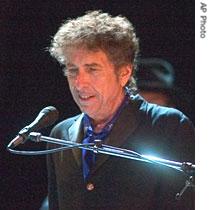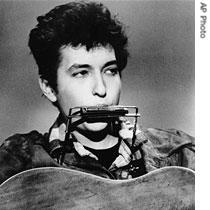-
(单词翻译:双击或拖选)
The second of two programs about the artist and the changes in his life and music in a career still going strong after 40 years. Transcript1 of radio broadcast:
15 June 2008
VOICE ONE:
Welcome to THIS IS AMERICA in VOA Special English. I'm Barbara Klein.
VOICE TWO:
And I’m Steve Ember. Singer and songwriter Bob Dylan has been performing for more than forty years. The sixty-seven year old musician and his band are currently2 on tour in Europe. Last week on our program, we looked back at his rise as a folk singer in the early nineteen sixties.
VOICE ONE:
Nineteen sixty-five was a turning point -- the year he "went electric." It would anger many fans of his folk music, but gain new fans of rock and roll.
(MUSIC)
 |
| Bob Dylan at the Pawtucket Arts Festival in 2006 |
"Like a Rolling Stone" was on Bob Dylan's sixth album, "Highway 61 Revisited." The single reached number two on the Billboard3 music charts in July of nineteen sixty-five.
The album came at a time when he was exploring different kinds of music. This new record included blues4 and rock influences. He also had excellent supporting musicians, including the famous blues guitarist Mike Bloomfield.
VOICE TWO:
Nineteen sixty-five was also the year he got married to Sara Lownds. But the pressure of performing internationally and producing records was building up. Then, in July of nineteen sixty-six, something happened that seemed to change everything.
He spent months out of public life. He needed the time, he said, to recover from injuries suffered in a motorcycle accident near his home in Woodstock, New York. Yet the events of that time have given writers and fans something to talk and debate about ever since.
During this period, he worked with some of the musicians he had traveled with that year. These musicians formed their own group, known simply as the Band. An album of Bob Dylan and the Band called the "Basement Tapes" was released5 in nineteen seventy-five.
(MUSIC)
VOICE ONE:
For several years, Bob Dylan did not make records as often as he had early in his career. Not only that, he began writing songs with a country music sound. In nineteen sixty-nine, he released the record "Nashville Skyline." It included the hit "Lay Lady Lay."
(MUSIC)
VOICE TWO:
 |
| Bob Dylan plays the harmonica and acoustic6 guitar in 1963 |
The young Bob Dylan, with the power and poetry of his folk music, was often called the voice of his generation. Yet he did not appear at his generation's most famous music festival. The Woodstock Music and Art Fair took place in August of nineteen sixty-nine. By then, this "voice of a generation" had moved on.
Through the early seventies, Bob Dylan continued to experiment with his sound. He worked with many different musicians. Then in nineteen seventy-five, in Minneapolis, he made a record that many consider one of his best. "Blood on the Tracks" included this song, "Shelter From the Storm."
(MUSIC)
In nineteen seventy-six, Bob Dylan released "Desire." It become a number one record.
The year before, he had started touring with a new group of musicians. They called their tour the Rolling Thunder Revue. It included folk performers like Joan Baez and Ramblin' Jack7 Elliott. Singer and songwriter Joni Mitchell also joined the tour. So did Arlo Guthrie, the son of Woody Guthrie, the biggest musical influence on Bob Dylan's early career.
Poet Allan Ginsberg took part in a film about the tour. And playwright8 Sam Shepard traveled with the group, writing about what he saw. His observations were later published as "The Rolling Thunder Logbook."
(MUSIC)
VOICE TWO:
Other changes were about to take place in Bob Dylan's life. In nineteen seventy-seven, he and his wife Sara divorced10. They had four children together and also raised a daughter from Sara's earlier marriage. (Their son Jakob Dylan, by the way, is a rock singer who put out a new album just last week.)
Two years later, in nineteen seventy-nine, Bob Dylan announced that he was a born-again Christian11. The Jewish-born performer expressed his new religion in three records, starting with "Slow Train Coming." It won him a Grammy Award for best rock vocal12 performance for "Gotta Serve Somebody."
(MUSIC)
VOICE ONE:
 |
| Bob Dylan plays his Fender Stratocaster guitar in London's Hyde Park in 1996 |
The nineteen eighties saw highs and lows for Bob Dylan. He and singer Carolyn Dennis secretly married in nineteen eighty-six and had a daughter. But that marriage also ended in divorce9, in nineteen ninety-two.
In "Chronicles," his autobiography13, Bob Dylan writes about a point during his touring when he lost feeling for his music. But he would find new reasons to perform and start what he calls his never-ending tour.
In nineteen eighty-eight, he was voted into the Rock and Roll Hall of Fame. The following year, he released the widely praised album "Oh Mercy."
(MUSIC)
VOICE TWO:
The past twenty years of Bob Dylan's career have been just as notable15 as the first. In nineteen ninety-one, he received a lifetime achievement Grammy. Six years later, he received the Kennedy Center Lifetime Achievement Award.
That same year, nineteen ninety-seven, he suffered a life-threatening heart infection. He healed16 quickly, however, and was back touring within the year. In nineteen ninety-seven he also released the album "Time Out of Mind." It received three Grammys.
Then he won an Academy17 Award for best song for "Things Have Changed" in the two thousand movie "Wonder Boys."
(MUSIC)
His album "Love and Theft" was released, by chance, on September eleventh, two thousand one. Music critics praised it. But some people said the words were similar to the book "Confessions18 of a Yakuza" by Japanese writer Junichi Saga19.
VOICE ONE:
In two thousand six, at the age of sixty-five, Bob Dylan returned to the top of the music world. He had a number one record with "Modern Times."
Bob Dylan continues to tour, playing about one hundred shows a year. He is also writing the second part of his autobiography. The first part of "Chronicles" was published in two thousand four. It reached number two on the New York Times best-seller list. It showed that people are still hungry to know about an artist who took his own road and never looked back.
(MUSIC)
VOICE TWO:
Our program was written and produced by Mario Ritter. I'm Steve Ember.
VOICE ONE:
And I’m Barbara Klein. Part one of our Bob Dylan biography14 can be found at voaspecialenglish.com. Join us again next week for THIS IS AMERICA in VOA Special English.
 收听单词发音
收听单词发音
1
transcript

|
|
| n.抄本,誊本,副本,肄业证书 | |
参考例句: |
|
|
|
2
currently

|
|
| adv.通常地,普遍地,当前 | |
参考例句: |
|
|
|
3
billboard

|
|
| n.布告板,揭示栏,广告牌 | |
参考例句: |
|
|
|
4
blues

|
|
| n.抑郁,沮丧;布鲁斯音乐 | |
参考例句: |
|
|
|
5
released

|
|
| v.释放( release的过去式和过去分词 );放开;发布;发行 | |
参考例句: |
|
|
|
6
acoustic

|
|
| adj.听觉的,声音的;(乐器)原声的 | |
参考例句: |
|
|
|
7
jack

|
|
| n.插座,千斤顶,男人;v.抬起,提醒,扛举;n.(Jake)杰克 | |
参考例句: |
|
|
|
8
playwright

|
|
| n.剧作家,编写剧本的人 | |
参考例句: |
|
|
|
9
divorce

|
|
| n.离婚;分离;vi.离婚;vt.离婚;脱离 | |
参考例句: |
|
|
|
10
divorced

|
|
| adj.离婚的;分开的;不相干的;脱离的v.与…离婚(divorce的过去式和过去分词);分离;与某人离婚,判某人离婚 | |
参考例句: |
|
|
|
11
Christian

|
|
| adj.基督教徒的;n.基督教徒 | |
参考例句: |
|
|
|
12
vocal

|
|
| adj.直言不讳的;嗓音的;n.[pl.]声乐节目 | |
参考例句: |
|
|
|
13
autobiography

|
|
| n.自传 | |
参考例句: |
|
|
|
14
biography

|
|
| n.个人经历,传记 | |
参考例句: |
|
|
|
15
notable

|
|
| adj.值得注意的,著名的;n.名人,要人 | |
参考例句: |
|
|
|
16
healed

|
|
| v.(使)愈合( heal的过去式和过去分词 );治愈;(使)结束;较容易忍受 | |
参考例句: |
|
|
|
17
academy

|
|
| n.(高等)专科院校;学术社团,协会,研究院 | |
参考例句: |
|
|
|
18
confessions

|
|
| n.承认( confession的名词复数 );自首;声明;(向神父的)忏悔 | |
参考例句: |
|
|
|
19
saga

|
|
| n.(尤指中世纪北欧海盗的)故事,英雄传奇 | |
参考例句: |
|
|
|















